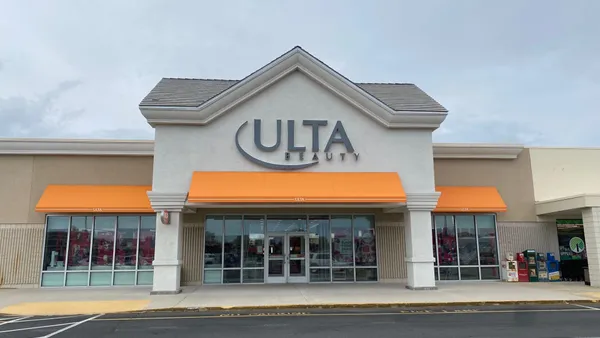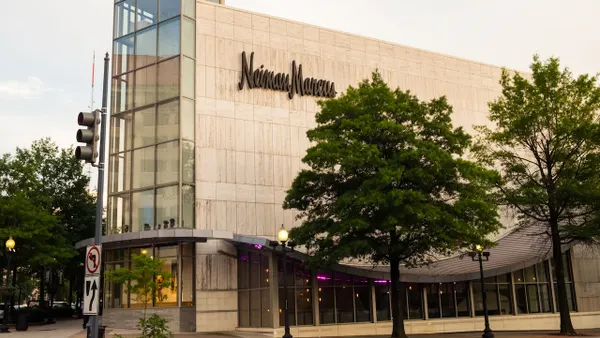Dive Brief:
-
Nordstrom and even its Rack off-price unit are losing customers and sales to lower-price rivals, according to new research from UBS analysts led by Jay Sole. The team has downgraded the department store to a "no-growth retailer," according to their report, which was emailed to Retail Dive.
-
Shoppers once flocked to Nordstrom for special occasion and other pricier apparel, but are now looking for wedding and other attire elsewhere, according to the report. The trend of wearing more casual clothing is also an issue for the retailer, UBS said.
-
UBS identified two areas for potential improvement — better loyalty program execution in the second half of the year and a new fashion cycle that could drive sales — but called that "a low probability scenario." The report follows a lowered outlook from S&P Global in May.
Dive Insight:
Nordstrom is one of the most innovative department stores in the U.S., and its troubles don't bode well for the entire segment.
"You need only look at something like Nordstrom's Local as an example of one of the few remaining viable department store retailers understanding what the next chapter looks like," retail analyst and consultant Sanford Stein, author of "Retail Schmetail," recently told Retail Dive in an interview.
Those are the company's merchandise-free stores, a re-imagining of the department store as a place to try out merchandise and hang out, but where purchases are fulfilled online and not in store. Nordstrom has expanded the Local concept in Los Angeles, which hosts the pilot location, and recently announced two more, in New York's West Village and Upper East Side this fall, according to a press release emailed to Retail Dive.
The company has partnered with and invested in several cutting edge concepts and brands, with mixed success. Most recently, Nordstrom and Rent the Runway teamed up for order pickup and return, and other services in four Los Angeles Nordstrom locations. Acquisitions include HauteLook and Trunk Club, the latter of which is now a styling service much like Stitch Fix. Its investment in Shoes of Prey ended up going nowhere, as the 10-year-old digitally native shoe brand shut down earlier this year.
The department store revamped its loyalty program last year, forging a new "Nordy Club" where members can earn rewards more quickly and even non-cardholders enjoy substantial perks. But this year, the execution of that suffered when the retailer cut paper mailings, hurting traffic. Digital marketing also lagged, and has since been ramped up, executives said in May.
But Nordstrom's troubles don't just stem from failures of its own efforts. The rising cost of living and relatively stagnant income thresholds for the middle class could be a factor, as consumers, especially younger ones contending with high student debt, remain keen on discounts. That means that, according to UBS, while Nordstrom "has historically been a share taker," it's no longer in a position to take market share.
Spending on apparel more generally is likely to remain subdued into the fall, according to UBS. "[H]igh-income US consumer spending will stay weak through the Fall season," UBS wrote, noting that its survey "shows consumers are migrating to [Nordstrom's] competitors for key items and think [Nordstrom's] prices are increasingly high relative to peers."
Add to that the trend of opting for less upscale clothing and it could spell trouble. "[W]hen consumers were asked what occasions they were planning to use the items they bought at each store they shopped at recently, the percentage who answered business or special occasions increased for many of [Nordstrom's] lower priced rivals, but decreased for Nordstrom and Nordstrom Rack," UBS said. "We think this reflects a cultural shift where consumers don't think they need to invest in the type of high-quality merchandise available at Nordstrom for work as much as they used to. It also likely reflects the 'casualization' trend, where consumers are 'dressing down' more often in every part of daily life. This is not something we think [Nordstrom] can easily recover from."
The retailer had a rough first quarter. Net sales in the period fell 3.5% to $3.4 billion, as full price net sales fell 5.1% to $2.1 billion and off-price Rack net sales fell 0.6% to $1.2 billion, according to the company, which no longer reports store comps. The weak quarter led to a guidance downgrade as well.
UBS on Tuesday expressed doubt that Nordstrom could reverse its margin decline and described a hole possibly too deep to dig out of. "We think [Nordstrom] is going to need to increase promotions in order to change price perceptions and drive traffic back into stores," the report said. "This likely has a negative impact on gross margin. Plus, we also doubt [Nordstrom] can leverage SG&A at the new, lower sales growth rate we're modeling."














